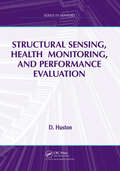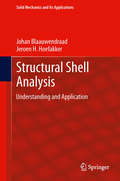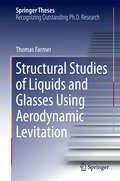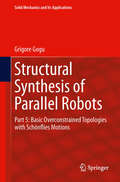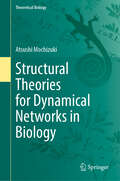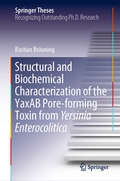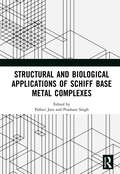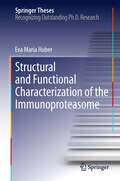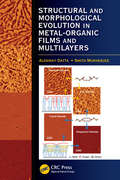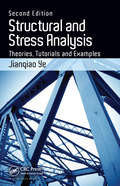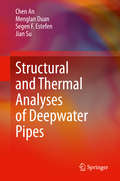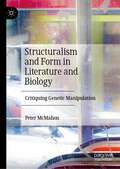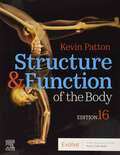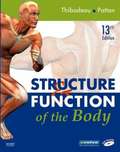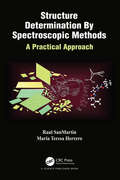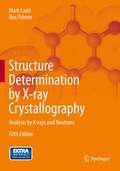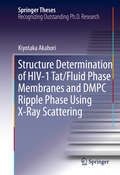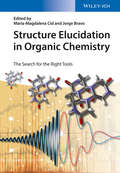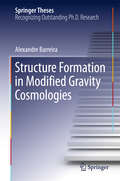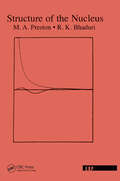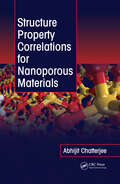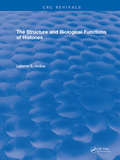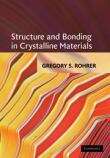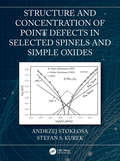- Table View
- List View
Structural Sensing, Health Monitoring, and Performance Evaluation (Series in Sensors)
by D. HustonStructural health monitoring (SHM) uses one or more in situ sensing systems placed in or around a structure, providing real-time evaluation of its performance and ultimately preventing structural failure. Although most commonly used in civil engineering, such as in roads, bridges, and dams, SHM is now finding applications in other engineering envir
Structural Shell Analysis: Understanding and Application
by Johan Blaauwendraad Jeroen H. HoefakkerThe mathematical description of the properties of a shell is much more elaborate than those of beam and plate structures. Therefore many engineers and architects are unacquainted with aspects of shell behaviour and design, and are not familiar with sufficiently reliable shell theories for the different shell types as derived in the middle of the 20th century. Rather than contributing to theory development, this university textbook focuses on architectural and civil engineering schools. Of course, practising professionals will profit from it as well. The book deals with thin elastic shells, in particular with cylindrical, conical and spherical types, and with elliptic and hyperbolic paraboloids. The focus is on roofs, chimneys, pressure vessels and storage tanks. Special attention is paid to edge bending disturbance zones, which is indispensable knowledge in FE meshing. A substantial part of the book results from research efforts in the mid 20th century at Delft University of Technology. As such, it is a valuable addition to the body of shell research literature of continuing importance. This work can be used for university courses. It also shows professionals how to perform manual calculations of the main force flow in shell structures, and provides guidance for structural engineers estimating stresses and deformations.
Structural Studies of Liquids and Glasses Using Aerodynamic Levitation
by Thomas FarmerThis thesis presents neutron scattering data that contribute to the understanding of four distinct areas of condensed matter physics, including iso-compositional liquid-liquid phase transitions and the glass formation in rare earth doped BaTi2O5. In situ aerodynamic levitation with laser heating was combined with neutron scattering in order to study both liquid-liquid phase transitions in (Y2O3)x(Al2O3)1-x and the atomic and magnetic ordering in liquid Invar. Among several significant results, obtained in this case from small angle neutron scattering, was the absence of a phase transition across a range of temperatures and compositions in the yttria aluminates As these are a principal system in which liquid-liquid phase transitions have been hypothesized, this is an important contribution in a contentious area.
Structural Synthesis of Parallel Robots
by Grigore GoguThis book represents the fifth part of a larger work dedicated to the structural synthesis of parallel robots. The originality of this work resides in the fact that it combines new formulae for mobility, connectivity, redundancy and overconstraints with evolutionary morphology in a unified structural synthesis approach that yields interesting and innovative solutions for parallel robotic manipulators. This is the first book on robotics that presents solutions for coupled, decoupled, uncoupled, fully-isotropic and maximally regular robotic manipulators with Schönflies motions systematically generated by using the structural synthesis approach proposed in Part 1. Overconstrained non-redundant/overactuated/redundantly actuated solutions with simple/complex limbs are proposed. Many solutions are presented here for the first time in the literature. The author had to make a difficult and challenging choice between protecting these solutions through patents and releasing them directly into the public domain. The second option was adopted by publishing them in various recent scientific publications and above all in this book. In this way, the author hopes to contribute to a rapid and widespread implementation of these solutions in future industrial products.
Structural Theories for Dynamical Networks in Biology (Theoretical Biology)
by Atsushi MochizukiThis textbook provides an introduction to theoretical biology using specific topics and explains the main mathematical methods. The book also introduces the &“structural theories&” developed by the author and his colleagues as new theoretical methods. Structural theories are mathematical theories that determine key aspects of the behavior of dynamical systems from network information alone. The book details the practical applications of these methods across several biological network systems and shows that they are practically useful for analyzing the behaviors of biological systems. The first half of the book focuses on the dynamics that arise from the regulation of biomolecular activity, such as gene expression and protein modification. The second half of the book approaches the understanding of the dynamics of complex systems composed of many biomolecules. Each chapter covers current and important topics in biological research, and its description of how biological phenomena are theoretically elucidated effectively conveys the importance and appeal of mathematical methods. This book is not only a comprehensive textbook on theoretical biology, but also a study guide for learning mathematical methods. It also serves as a specialized reference for systematically learning new mathematical theories. The &“Mathematical Methods&” section at the end of each chapter offers a concise summary and facilitates efficient learning for readers, along with the exercises. Target readers of this book are from upper undergraduate students to senior researchers interested in the dynamics of complex network systems in biology. It appeals to both mathematical and experimental biologists, as well as chemists and physicists.
Structural and Biochemical Characterization of the YaxAB Pore-forming Toxin from Yersinia Enterocolitica (Springer Theses)
by Bastian BräuningThis book discusses the decoding of the lytic mechanism of an α-helical pore-forming toxin, YaxAB, composed of two different subunits. Pore-forming toxins (PFTs) are among the most common bacterial toxins. They are produced by a variety of pathogens, which infect a wide range of organisms including plants, insects and humans. Yet the maturation of these particles and the structural changes required for pore formation are still poorly understood for many PFT families. Using a diverse panel of biochemical and structural techniques, including X-ray crystallography and cryo-electron microscopy, Dr. Bräuning and colleagues have succeeded in identifying the mechanistic contributions of the two toxin components and elucidating the lytic state of the pore complex. The results of this thesis on the YaxAB system are applicable to orthologues from agriculturally relevant insect pathogens, and offer valuable structural and mechanistic insights to inform future bioengineering efforts.
Structural and Biological Applications of Schiff Base Metal Complexes
by Pallavi Jain Prashant SinghCoordination compounds have been well-known for their wide variety of applications for over a century, as well as enhancing the researcher’s interest and concern in evaluating their action mechanism. It is certainly one of the most intensely discussed research topics. Coordination compounds involve different metal-ion-ligand phenomenon. The involved metal ions play a significant role in structural association and functioning of several processes in the genetic and metabolism system. In recent years, Schiff base ligands have gained significant interest and received a keen interest of many researchers. Schiff’s base ligands have been recognized to hold a wide variety of biological and medicinal activities due to the presence of donor atoms. They have proved exceptional pharmalogical actions such as antimicrobial, anti-tuberclosis, antiplatelet, antidiabetic, antiarthritis, antioxidant, anti-inflammatory, anticancer, antiviral, antimalarial, and analgesic. These biologically active Schiff base ligands have also been shown to inhibit enzyme mobilization and, when bound to a metal ion, exhibit enhanced biological activity, making them useful in a number of fields. As a result, metal complexes of Schiff base ligands are gaining popularity due to their unique properties and functionalities. Schiff base complex-based research for educational and industrial purposes is booming, and the number of publications is gradually increasing. Despite these interests, there is currently no detailed book on Schiff base metal complexes that covers the structures, biological activities, and other non-biological perspectives.This book delves into the structures of Schiff base metal complexes, which are critical in assessing the biological viability of any complex. It also highlights their biological significance in pharma and drug discovery like antibacterial, antifungal, anticancer, anti-inflammatory, anti-arthritis, anti-diabetic, antioxidants, anti-proliferative, antitumor, anticancer, antiviral. The fundamentals of metal complexes are described, as well as an up-to-date outline of developments in synthesis, characterization methods, properties- chemical, thermal, optical, structural, and applications. This book also discusses the other applications of Schiff base metal complexes: as sensor (luminescent, electrochemical, and biosensor), as pigments in dying and paint industries, as photocatalyst to improve the degradation rate.Features : This book would be useful for academia, researchers and engineers working in the area of Schiff base and their metal complexes. This book will give an in-depth account of the properties of Schiff base and their metal complexes. This book will discuss the details of synthesis methods for Schiff base and their metal complexes. This book will cover emerging trends in the use of Schiff base metal complexes in the industry. This book will provide an overview of the wider biological applications of Schiff base metal complexes
Structural and Functional Characterization of the Immunoproteasome
by Eva Maria HuberIn this acclaimed thesis, Eva Maria Huber reveals ground-breaking results by elucidating the crystal structure of the murine immunoproteasome in complex with a selective inhibitor. Huber does this by performing multidisciplinary methodologies including X-ray crystallography, fluorescence spectroscopy and mutagenesis experiments. Her exceptional results explore the immunoproteasome complex structures and are of outstanding importance for future scientific research especially in the pharmaceutical industry. These results will enable the functional analysis of individual proteasome subunits and support the development of novel drugs for autoimmune diseases such as multiple sclerosis or rheumatoid arthritis.
Structural and Morphological Evolution in Metal-Organic Films and Multilayers
by Alokmay Datta Smita MukherjeeStructural and Morphological Evolution in Metal-Organic Films and Multilayers presents major results of the authors' work carried out on Langmuir monolayers and Langmuir-Blodgett multilayers. The authors address two important questions:Are metal-organic monolayer systems more like solids or more like liquids?Does a two-dimensional system have diffe
Structural and Stress Analysis: Theories, Tutorials and Examples, Second Edition
by Jianqiao YeNew Edition Now Covers Thin Plates, Plastic Deformation, Dynamics and VibrationStructural and stress analysis is a core topic in a range of engineering disciplines - from structural engineering through to mechanical and aeronautical engineering and materials science.Structural and Stress Analysis: Theories, Tutorials and Examples, Second Edition&nb
Structural and Thermal Analyses of Deepwater Pipes
by Chen An Menglan Duan Segen F. Estefen Jian SuThis book focuses on advanced methods for the structural and thermal analysis of deepwater pipelines and risers. It discusses the limit strength of sandwich pipes, including finite-element analysis using Python scripts, collapse of sandwich pipes with cementitious/polymer composites, buckle propagation of sandwich pipes, dynamic behavior of subsea pipes, flow-induced vibration of functionally graded pipes, two-phase flow-induced vibration of pipelines, vortex-induced vibration of free-spanning pipelines, and the thermal analysis of composites pipes with passive insulation, active heating, and phase change material layers. It also explores structural analysis using finite element analysis and the integral transform technique for fluid-structure interaction. Lastly, the use of lumped parameter formulations combined with finite differences for the thermal analysis of pipelines is examined.
Structuralism and Form in Literature and Biology: Critiquing Genetic Manipulation
by Peter McMahonThe book considers biology in parallel with philosophical structuralism in order to argue that notions of form in the organism are analogous to similar ideas in structuralist philosophy and literary theory. This analogy is then used to shed light on debates among biological scientists from the turn of the 19th century to the present day, including Cuvier, Geoffroy Saint-Hilaire, Dawkins, Crick, Goodwin, Rosen and West-Eberhard. The book critiques the endorsement of genetic manipulation and bioengineering as keys to solving agricultural and environmental problems, suggesting that alternative models have been marginalized in the promotion of this discourse. Drawing from the work of philosophers including Cassirer, Saussure, Jakobson and Foucault the book ultimately argues that methods based on agroecology, supported by molecular applications (such as marker-assisted selection, MAS), can both advance agricultural development and remain focused on the whole organism.
Structure & Function of the Body
by Gary A. Thibodeau Kevin T. PattonGet a solid understanding of the human body! Using simple, conversational language and vivid animations and illustrations, Structure & Function of the Body, 16th Edition introduces the normal structure and function of the human body and what the body does to maintain homeostasis. To help make difficult A&P concepts easy to understand, this new edition features thoroughly revised content and review questions which reflect the most current information available and a unique 22-page, semi-transparent insert of the human body. Plus, Connect It! boxes throughout directly correlate to online content giving you additional clinical and scientific insights essential to patient care!
Structure & Function of the Body 13th Edition
by Gary A. Thibodeau Kevin T. PattonThis textbook concentrates on the normal structures and function of the human body and on what the body does to maintain homeostasis. Chapters discuss topics like biochemistry, cells and tissue, the various organ systems, the senses, blood, immunity, nutrition and metabolism, fluid and electrolyte balance, acid-base balance, and growth and development. Approximately 330 color illustrations and cadaver photographs visually represent the anatomy under discussion. Thibodeau taught biology at the University of Wisconsin-River Falls. Patton teaches life sciences at Saint Charles Community College. Annotation ©2004 Book News, Inc. , Portland, OR (booknews. com)
Structure Determination By Spectroscopic Methods: A Practical Approach
by Raul SanMartin Maria Teresa HerreroThe authors travel with the reader through the challenging maze of structure determination, showing how to distinguish between valuable and deceiving data from IR, NMR and MS spectra, extracting structural conclusions and putting all the pieces together to solve the structure elucidation puzzle. Indeed, human reasoning is key to combining the information contained in those bands, signals and peaks by a rationale that enables the makeup of a chemical structure. A number of increasingly more complex problems will act as trip segments and, in addition to the spectra themselves, each chapter is supplemented with figures and tables that decipher the above data and serve as maps for the journey.
Structure Determination by X-ray Crystallography
by Mark Ladd Rex PalmerThe advances in and applications of x-ray and neutron crystallography form the essence of this new edition of this classic textbook, while maintaining the overall plan of the book that has been well received in the academic community since the first edition in 1977. X-ray crystallography is a universal tool for studying molecular structure, and the complementary nature of neutron diffraction crystallography permits the location of atomic species in crystals which are not easily revealed by X-ray techniques alone, such as hydrogen atoms or other light atoms in the presence of heavier atoms. Thus, a chapter discussing the practice of neutron diffraction techniques, with examples, broadens the scope of the text in a highly desirable way. As with previous editions, the book contains problems to illustrate the work of each chapter, and detailed solutions are provided. Mathematical procedures related to the material of the main body of the book are not discussed in detail, but are quoted where needed with references to standard mathematical texts. To address the computational aspect of crystallography, the suite of computer programs from the fourth edition has been revised and expanded. The programs enable the reader to participate fully in many of the aspects of x-ray crystallography discussed in the book. In particular, the program system XRAY* is interactive, and enables the reader to follow through, at the monitor screen, the computational techniques involved in single-crystal structure determination, albeit in two dimensions, with the data sets provided. Exercises for students can be found int the book, and solutions are available to instructors.
Structure Determination of HIV-1 Tat/Fluid Phase Membranes and DMPC Ripple Phase Using X-Ray Scattering
by Kiyotaka AkaboriThis Thesis in biological physics has two components, describing the use of X-ray scattering techniques to study the structure of two different stacked lipid membrane systems. The first part focuses on the interaction between a short 11-mer peptide, Tat, which is part of the Tat protein in the HIV-1 virus. Although highly positively charged, the Tat protein has been shown to translocate through hydrocarbon lipid bilayers easily, without requiring the cell's energy, which is counter to its Born self-energy. In this work Tat's location in the headgroup region was demonstrated using a combined X-ray scattering and molecular dynamics approach. Bilayer thinning was observed as well as softening of different membrane mimics due to Tat. It was concluded that Tat's headgroup location, which increases the area/lipid, and its bilayer softening likely reduce the energy barrier for passive translocation. The second part is a rigorous investigation of an enigmatic phase in the phase diagram of the lipid dimyristoylphosphatidylcholine (DMPC). The ripple phase has fascinated many researchers in condensed matter physics and physical chemistry as an example of periodically modulated phases, with many theoretical and simulation papers published. Despite systematic studies over the past three decades, molecular details of the structure were still lacking. By obtaining the highest resolution X-ray data so far, this work revealed the complex nature of the chain packing, as well as confirming that the major side is thicker than the minor side of the saw-tooth ripple structure. The new model shows that the chains in the major arm are tilted with respect to the bilayer normal and that the chains in the minor arm are slightly more disordered than all-trans gel-phase chains, i. e. , the chains in the minor arm are more fluid-like. This work provides the highest resolution X-ray structure of the ripple phase to-date.
Structure Elucidation in Organic Chemistry
by Maria-Magdalena Cid Jorge BravoIntended for advanced readers, this is a review of all relevant techniques for structure analysis in one handy volume. As such, it provides the latest knowledge on spectroscopic and related techniques for chemical structure analysis, such as NMR, optical spectroscopy, mass spectrometry and X-ray crystallography, including the scope and limitation of each method. As a result, readers not only become acquainted with the techniques, but also the advantages of the synergy between them. This enables them to choose the correct analytical method for each problem, saving both time and resources. Special emphasis is placed on NMR and its application to absolute configuration determination and the analysis of molecular interactions. Adopting a practical point of view, the author team from academia and industry guarantees both solid methodology and applications essential for structure determination, equipping experts as well as newcomers with the tools to solve any structural problem.
Structure Formation in Modified Gravity Cosmologies
by Alexandre BarreiraThis unique thesis covers all aspects oftheories of gravity beyond Einstein's General Relativity, from setting up theequations that describe the evolution of perturbations, to determining thebest-fitting parameters using constraints like the microwave backgroundradiation, and ultimately to the later stages of structure formation usingstate-of-the-art N-body simulations and comparing them to observations ofgalaxies, clusters and other large-scale structures. This truly ground-breakingwork puts the study of modified gravity models on the same footing as thestandard model of cosmology. Since the discovery of the accelerating expansionof the Universe, marked by the awarding of the 2011 Nobel Prize in Physics,there has been a growing interest in understanding what drives thatacceleration. One possible explanation lies in theories of gravity beyondEinstein's General Relativity. This thesis addresses all aspects of the problem,an approach that is crucial to avoiding potentially catastrophic biases in theinterpretation of upcoming observational missions.
Structure Of The Nucleus
by M. A. PrestonA graduate-level one-volume textbook and reference work on the structure and physics of atomic nuclei. Throughout this book the underlying emphasis is on how a nucleus is constituted through the interaction between the nucleons. The book is structured into three parts: the first part contains a detailed treatment of the two-nucleon force and of basic model-independent nuclear properties the second part discusses the experimental results of nuclear models and their bases in fundamental theory the third part deals in some detail with alpha-decay and fission.
Structure Property Correlations for Nanoporous Materials
by Abhijit ChatterjeeNanoporous materials are critical to various fields of research, including ion exchange, separation, catalysis, sensor applications, biological molecular isolation, and purification. In addition, they offer new opportunities in such areas as inclusion chemistry, guest-host synthesis, and molecular manipulations and reactions at the nanoscale. In St
Structure and Biological Functions of Histones
by L.S. HnilicaThis book endeavours to present an analysis of the current knowledge of the structure properties and possible functions of histones. The broad scope of this topic prevents the discussion of certain individual aspects in any detail. For this purpose, some of the more specialised review articles should be consulted. However, the present volume will contribute to a more general understanding of histone biochemistry and will provide stimulation, as well as source references, to the student of the cell nucleus and its functions.
Structure and Bonding in Crystalline Materials
by Gregory S. RohrerHow can elements be combined to produce a solid with specified properties? This book acquaints readers with the established principles of crystallography and cohesive forces needed to address the fundamental relationship among composition, structure and bonding. Starting with an introduction to periodic trends, the book discusses crystal structures and the various primary and secondary bonding types, and finishes by describing a number of models for predicting phase stability and structure. Its large number of worked examples, exercises, and detailed descriptions of numerous crystal structures make this an outstanding advanced undergraduate or graduate-level textbook for students of materials science.
Structure and Concentration of Point Defects in Selected Spinels and Simple Oxides
by Andrzej Stokłosa Stefan S. KurekStructure and Concentration of Point Defects in Selected Spinels and Simple Oxides presents diagrams and numerical data of important properties of spinels and oxides based on experimental results published in the literature. The values of many parameters presented can be used for optimization of preparation of new systems, to predict the practical properties of these systems. Applications include electronic devices, new metallic alloys with improved corrosion resistance, new ceramic materials, and novel catalysts, particularly for oxygen evolution and reduction reactions. Organized into four comprehensive parts, the authors present the problem of the structure and concentration of ionic and electronic defects in magnetite and hausmannite, pure and doped with M3+ cations, and in spinels exhibiting magnetic properties and high electric conductance. Additional Features include: Includes 236 figures presenting equilibrium diagrams of point defects and other useful details related to stoichiometric and nonstoichiometric spinels and oxides. Details novel methods of calculation of equilibria involving point defects. Collects scattered data published in nearly 500 original articles since the 1950s on spinels and oxides in one useful volume. Building upon the data presented, this book is an indispensable reference for material scientists and engineers developing new metal or oxide-based systems can easily calculate other useful parameters and compare the properties of different materials to select the best candidates for an intended use.
Structure and Dynamics of Asymmetric Interactions
by Naohito ChinoThis book integrates the fundamentals of asymmetric multidimensional scaling, spectral graph theory, graph embedding theory, and various dynamical systems theories, that deal with the static and dynamic aspects of asymmetric phenomena. In this way, it provides a comprehensive introduction to theories and methods for analyzing phenomena observed universally in social, behavioral, economical, geographical, biological, neural, chemical reaction and other networks. The topics addressed in here include the notions of asymmetric similarity matrices, graph spectra, dimension reduction, and difference and differential equations to describe the dynamics of networks, bifurcation of vector fields, Mandelbrot sets, fractals and chaos, and Hilbert spaces. Illustrated by carefully chosen examples and supported by extensive simulation studies, the book is highly recommended to readers who seek to discover static asymmetric structures among members or nodes. It also appeals to those who want to understand the kinds of dynamics that are theoretically possible in their research domains.
